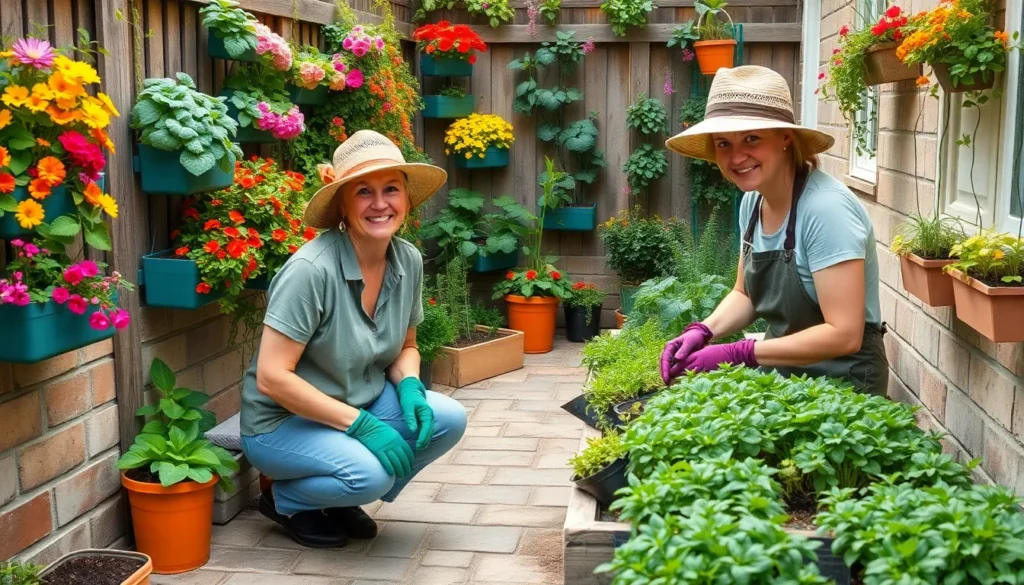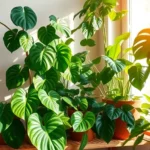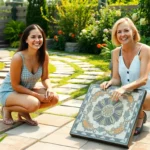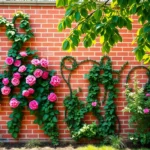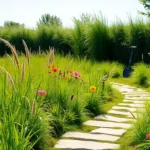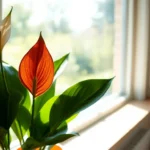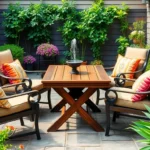We know how frustrating it can feel when you’re passionate about gardening but only have a tiny outdoor space to work with. That cramped backyard or narrow side yard doesn’t have to limit your green dreams – it just means we need to get creative with every square inch.
Small yards present unique opportunities that larger spaces simply can’t offer. We can create intimate garden rooms that feel cozy rather than cramped and design vertical growing systems that maximize our planting potential. The key lies in smart planning and choosing the right plants and features for our exact space.
Whether you’re working with a postage-stamp patio or a narrow strip of soil we’ll show you how to transform your small yard into a lush garden oasis. From space-saving container gardens to clever storage answers that double as planters we’ve got practical ideas that’ll make your neighbors wonder how you fit so much beauty into such a compact space.
Maximize Vertical Space With Living Walls and Trellises
When ground space becomes scarce, we can transform bare walls and fences into productive growing areas. Vertical gardening techniques allow us to triple our planting capacity while adding visual interest to small yards.
Install Wall-Mounted Planters for Herbs and Flowers
Wall-mounted planters offer immediate answers for growing herbs and colorful blooms without sacrificing precious ground space. We can attach pocket planters, rail systems, or individual containers directly to fences, shed walls, or exterior house walls to create stunning displays.
Popular wall planter options include:
- Fabric pocket planters that hold 6-12 plants each
- Metal rail systems with adjustable containers
- Cedar planter boxes mounted on brackets
- Repurposed pallets converted into vertical gardens
Position these planters at eye level for easy harvesting and maintenance. We recommend choosing lightweight containers and ensuring proper drainage to prevent water damage to walls. Herbs like basil, parsley, and mint thrive in wall-mounted systems, while trailing flowers such as petunias and nasturtiums create cascading color effects.
Create Climbing Gardens With Vines and Trailing Plants
Climbing plants naturally maximize vertical growing space while providing privacy screens and attractive focal points. We can establish these living walls using existing structures or simple support systems to create lush green backdrops.
Fast-growing climbing options include:
- Morning glories that reach 10-15 feet in one season
- Clematis vines producing abundant flowers
- Edible climbing beans and peas
- Grape vines for fruit production
Install wire mesh panels or string systems against walls to guide plant growth upward. Training techniques involve gently wrapping young shoots around supports and pruning excess growth to maintain desired shapes. These vertical gardens require consistent watering but produce impressive coverage within months.
Build DIY Trellis Systems for Vegetables
Custom trellis systems allow us to grow vertical vegetable gardens that produce substantial harvests in minimal ground space. We can construct these structures using basic materials and adapt them to exact crop requirements.
| Trellis Type | Best For | Materials Needed | Height Range |
|---|---|---|---|
| A-frame | Beans, peas | 2×4 lumber, chicken wire | 6-8 feet |
| Teepee | Cucumbers, squash | Bamboo poles, twine | 5-7 feet |
| Wall-mounted | Tomatoes, peppers | Metal brackets, wire panels | 4-6 feet |
| Obelisk | Decorative vines | Cedar strips, screws | 6-8 feet |
Build these structures using weather-resistant materials and anchor them securely to prevent toppling during storms. Position trellises to receive adequate sunlight while avoiding shade on neighboring plants. We find that vertical vegetable gardens often produce higher yields per square foot compared to traditional horizontal plantings.
Utilize Container Gardening for Maximum Flexibility
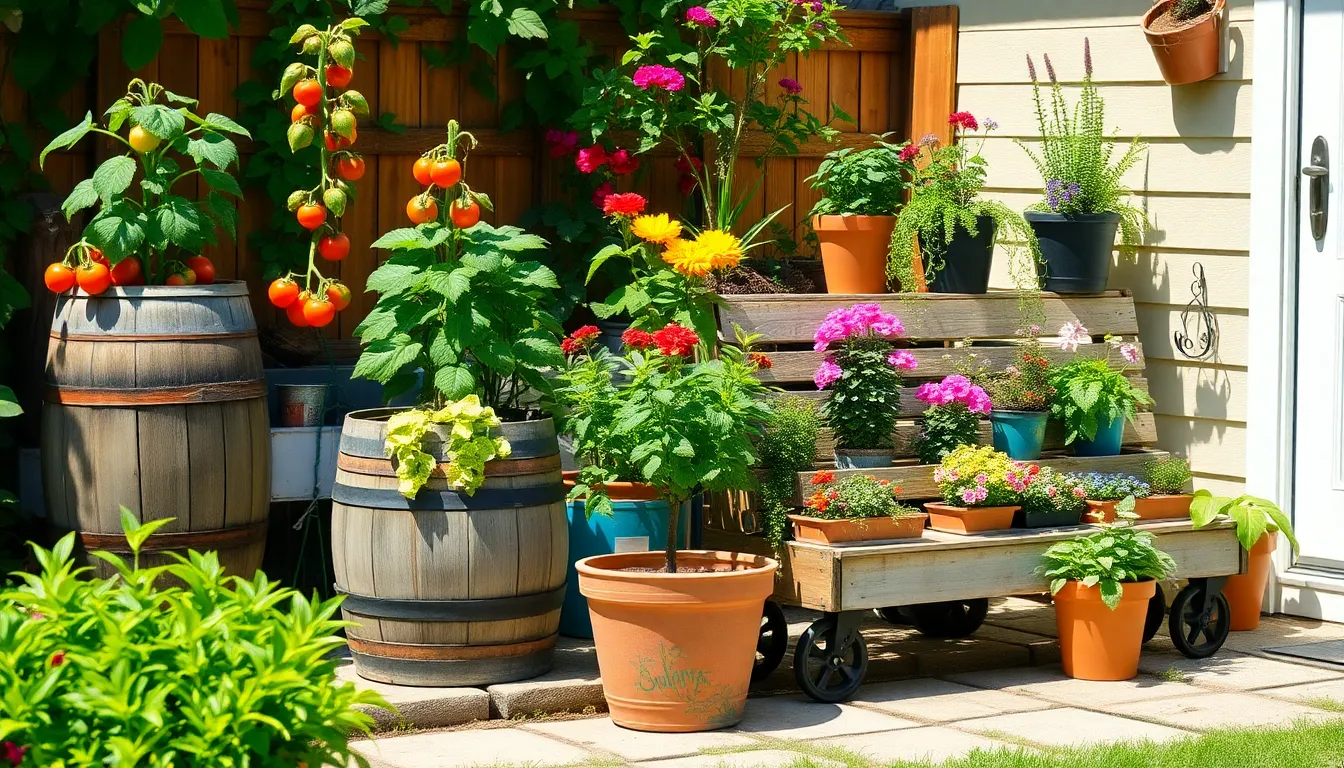
Container gardening transforms small yards into productive spaces while offering unmatched versatility for plant care and garden design.
Choose Multi-Functional Pots and Raised Planters
Multi-functional pots serve dual purposes in small yard container gardens. Rustic barrels create vintage charm while accommodating plants with deep root systems like tomatoes and peppers. Storage planters combine growing space with hidden compartments for garden tools and supplies.
Raised planters elevate your garden both literally and figuratively. We recommend selecting raised containers that improve soil quality control and reduce back strain during maintenance. Self-watering planters incorporate water reservoirs that maintain consistent moisture levels for up to two weeks.
Decorative storage benches with built-in planters provide seating while housing herbs or flowers. These dual-purpose containers maximize functionality in compact spaces where every square foot counts.
Create Mobile Garden Stations With Wheeled Containers
Mobile garden stations revolutionize small yard flexibility through strategic plant positioning. Wheeled containers allow us to chase sunlight throughout the day, moving shade-loving plants away from afternoon heat.
Rolling herb gardens bring fresh ingredients directly to outdoor dining areas. We position these mobile stations near patios during entertaining, then relocate them to optimal growing positions afterward.
Seasonal mobility extends growing seasons significantly. Moving tender plants indoors during frost warnings protects investments while allowing year-round cultivation. Heavy-duty casters support containers weighing up to 200 pounds when fully planted and watered.
Weather protection becomes effortless with mobile systems. Rolling containers under overhangs during storms prevents damage from hail or excessive rainfall.
Design Tiered Container Arrangements for Visual Interest
Tiered arrangements create dramatic focal points while maximizing growing space in small yards. Stacked containers of varying sizes generate depth and dimension that flat gardens can’t achieve.
Height variation draws the eye upward, making small spaces appear larger. We arrange tall containers in back positions with medium and small pots cascading forward in descending order.
Plant selection enhances tiered displays through contrasting textures and colors. Combining spiky plants like ornamental grasses with trailing varieties such as sweet potato vines creates ever-changing visual flow.
Stability considerations require secure stacking methods for safety. Using plant stands, inverted pots, or purpose-built tiered planters prevents toppling while maintaining attractive arrangements. Weight distribution places heaviest containers at bottom levels to ensure structural integrity.
Transform Unused Corners Into Productive Garden Spaces
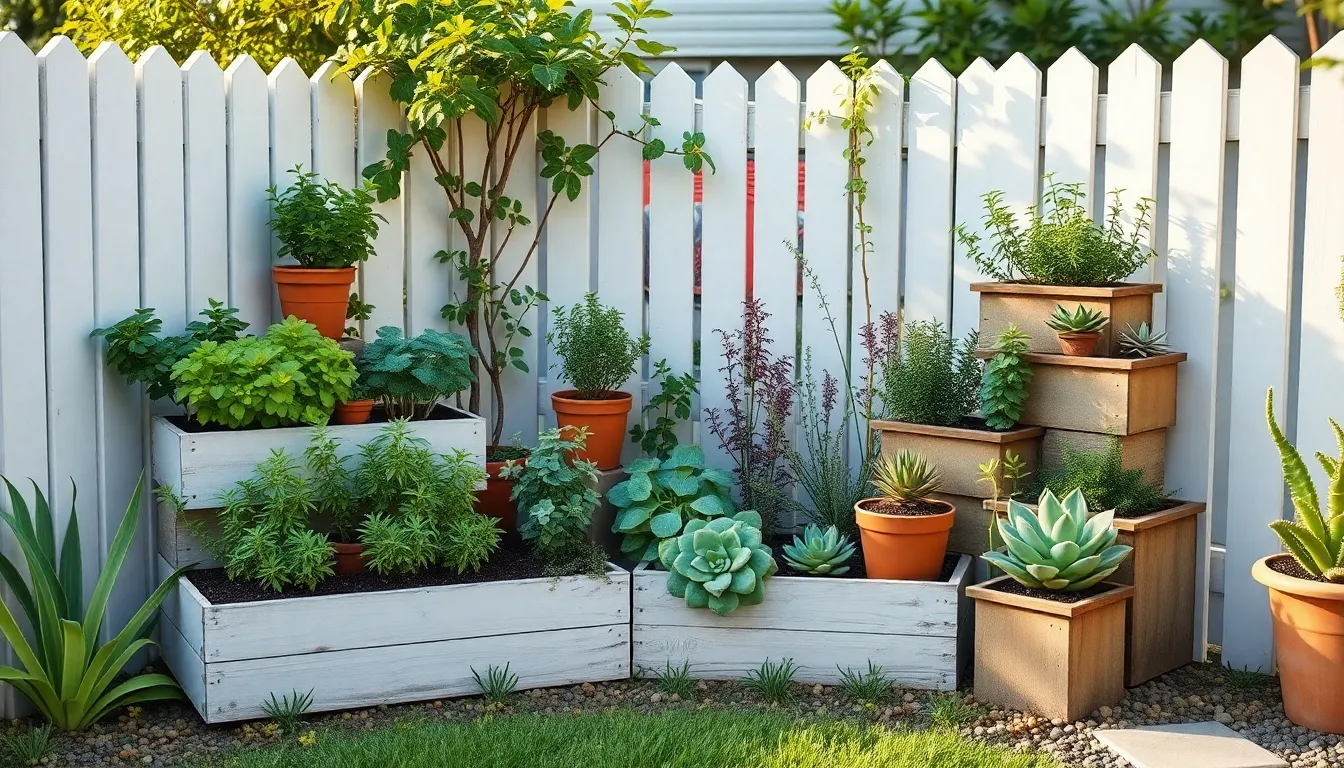
Corner spaces and awkward areas in small yards offer untapped potential for expanding our growing capacity. We can transform these overlooked zones into thriving garden features that maximize every square foot.
Convert Side Yards Into Narrow Growing Strips
Side yards provide excellent opportunities for creating linear garden beds that maximize limited width. We recommend establishing narrow growing strips along fence lines or building walls where plants can receive adequate sunlight while utilizing minimal ground space.
Linear garden design works particularly well for herbs, lettuce, and other compact vegetables that don’t require extensive root systems. Climbing vines and trellises make the most of vertical space in these narrow corridors, allowing us to grow beans, peas, and flowering vines upward rather than outward.
Strategic plant selection ensures our side yard strips remain productive throughout growing seasons. Shallow rooted plants like salad greens, herbs, and compact flowers thrive in confined spaces while providing continuous harvests for our kitchen needs.
Develop Corner Nooks With Compact Plant Varieties
Corner planters and tiered arrangements create productive growing spaces in previously unused areas of our small yards. We can select compact plant varieties like succulents, dwarf shrubs, and miniature herbs that fit perfectly into corner configurations without overwhelming the space.
Tiered planters maximize vertical growing potential while maintaining easy access for maintenance and harvesting. These arrangements work exceptionally well for herb gardens where we need frequent access to fresh basil, oregano, and thyme for cooking.
Small water features or seating elements enhance the ambiance of corner nooks while maintaining their productive capacity. We can incorporate these design elements to create multifunctional spaces that serve both aesthetic and practical purposes in our small yard gardens.
Use Awkward Spaces With Custom-Built Planters
Irregularly shaped spaces require creative answers through wall mounted planters and hanging baskets designed to fit exact dimensions. We can design custom planters that transform challenging areas like narrow walkways, sloped sections, or corners with unusual angles into productive growing zones.
Shallow rooted plants like salad leaves and herbs perform exceptionally well in custom built containers where traditional garden beds won’t fit. These plants adapt easily to confined growing conditions while providing fresh produce for our daily meals.
Wall mounted planters offer vertical growing answers for spaces too narrow for ground level gardens. We can install these systems along fences, garage walls, or property boundaries to create productive growing areas without sacrificing valuable floor space in our small yards.
Implement Multi-Level Gardening Techniques
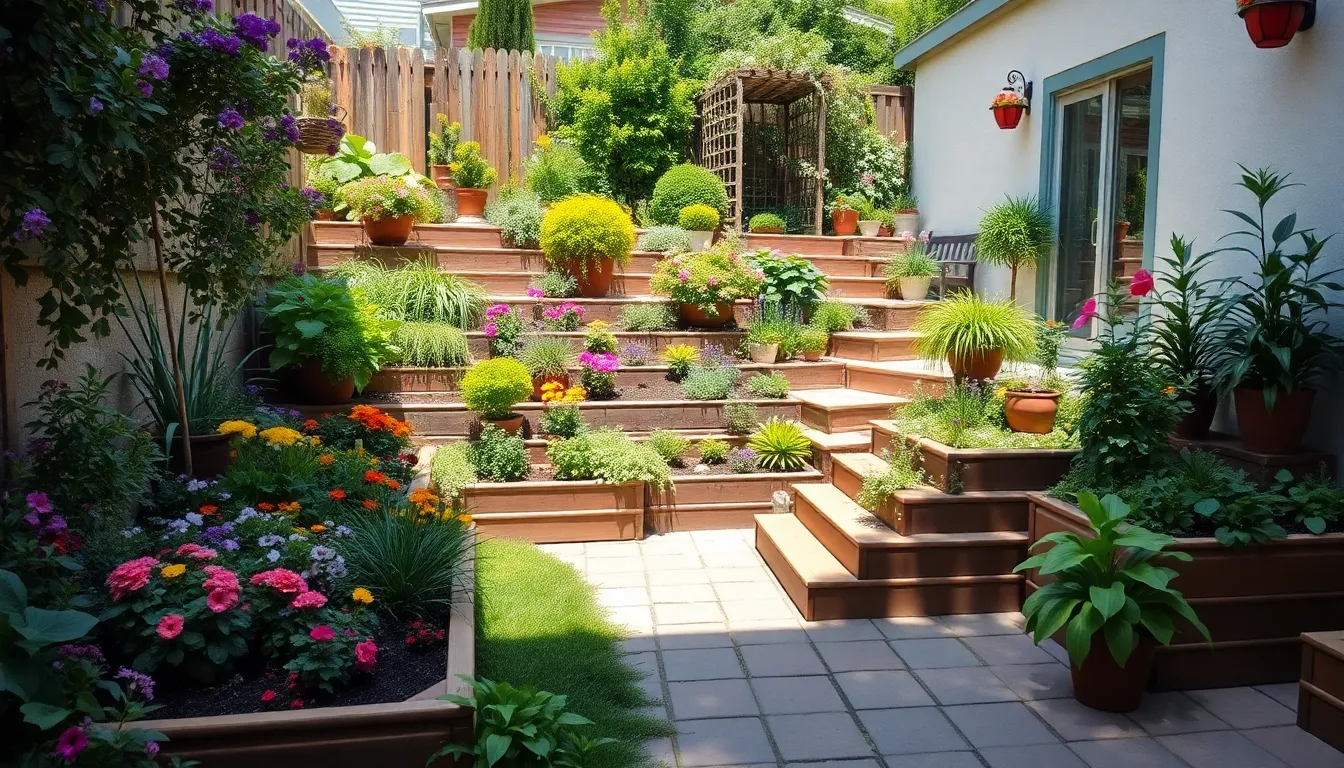
Multi-level gardening transforms small yards by creating layers of growing space that maximize every square foot. We’ll explore three effective approaches that work together to build organized, efficient garden systems.
Build Raised Garden Beds for Better Organization
Raised garden beds offer superior drainage compared to ground-level planting while eliminating the need for tilling. We position these elevated planters along walls or in corners to optimize available space without overwhelming the yard’s layout.
Beginning gardeners benefit most from raised bed systems because they provide better soil control and easier maintenance access. These structures create defined growing zones that prevent plants from competing for space and nutrients.
Corner placement of raised beds maximizes unused areas while maintaining clear pathways through the garden. We recommend building beds 18-24 inches high to reduce bending and strain during planting and harvesting activities.
Materials like cedar or composite lumber create durable raised bed frames that blend seamlessly with existing landscaping features. The improved drainage prevents waterlogged soil conditions that often plague small yard gardens.
Create Terraced Gardens on Sloped Areas
Terraced gardens prevent soil erosion while transforming challenging slopes into productive growing spaces. We design these stepped levels to create separate planting zones for different plant types and growing requirements.
Sloped areas become manageable garden spaces when divided into horizontal terraces that retain soil and moisture effectively. Each terrace level accommodates exact plant varieties based on sun exposure and drainage needs.
Stone or timber retaining walls support each terrace level while adding visual interest to the overall garden design. We space terraces 2-3 feet apart vertically to allow adequate growing room and easy access for maintenance.
Natural drainage flows between terrace levels, reducing the need for complex irrigation systems in small yard gardens. This technique maximizes planting area on previously unusable sloped ground.
Design Stepped Planting Systems for Small Patios
Stepped planting systems create dramatic height variation using wooden or stone planters arranged in ascending tiers. We showcase different plant varieties across multiple levels to enhance visual appeal and maximize growing capacity.
Small patios accommodate these tiered arrangements without overwhelming the available space or blocking essential pathways. The stepped design allows each plant layer to receive adequate sunlight and air circulation.
Wooden planters offer flexibility for seasonal rearrangement while stone options provide permanent structure and weather resistance. We combine both materials to create ever-changing stepped displays that evolve throughout growing seasons.
Variety displays flourish in stepped systems where trailing plants cascade from upper levels while compact varieties fill lower tiers. This layered approach transforms limited patio space into productive growing areas that serve multiple functions.
Incorporate Space-Saving Edible Garden Solutions
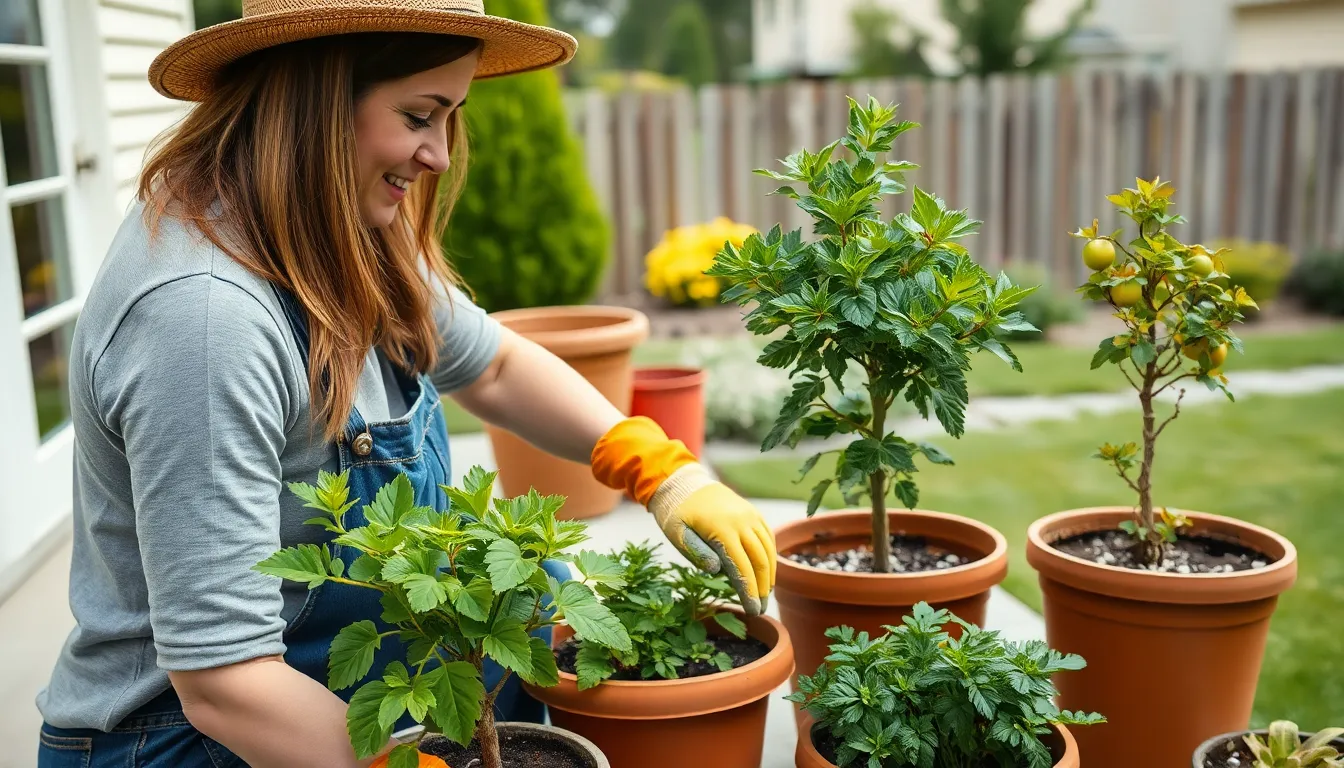
Maximizing our food production in limited yard space requires strategic selection of edible plants that deliver exceptional yields. We can transform even the smallest outdoor areas into productive food gardens by choosing compact varieties and efficient growing methods.
Plant Dwarf Fruit Trees in Large Containers
Dwarf fruit trees provide fresh fruit harvests without requiring permanent ground space in our small yards. Citrus varieties like meyer lemons and key limes thrive in large containers, producing full-sized fruit on compact 4-6 foot trees. Apple trees bred for container growing deliver bushels of apples while occupying just a few square feet of patio space.
Container growing allows us to move fruit trees seasonally for optimal sun exposure and winter protection. We’ll need containers at least 20-24 inches wide with drainage holes to support healthy root development. Standard potting mix combined with compost creates the ideal growing medium for containerized fruit trees.
Grow Compact Vegetable Varieties in Small Plots
Compact vegetable varieties maximize our harvest potential in minimal growing space. Cherry tomatoes produce continuously throughout the season in spaces as small as 12 inches square, delivering pounds of fruit from single plants. Leafy greens like lettuce and spinach mature quickly in tight spacing, allowing for successive plantings every 2-3 weeks.
Miniature peppers and bush beans require only 6-8 inches between plants while producing full-sized vegetables. We can intercrop fast-growing radishes between slower-maturing crops to use every inch of available soil. Baby carrots and finger-sized eggplants provide gourmet harvests from compact garden plots.
Design Kitchen Gardens With High-Yield Crops
Kitchen gardens focused on high-yield crops ensure continuous harvests from our small growing spaces. Herbs like basil and cilantro regenerate quickly after cutting, providing fresh seasonings throughout the growing season. Lettuce varieties produce multiple cuttings from single plants, delivering salad greens for months.
Spinach offers exceptional nutrition density while requiring minimal space, producing tender leaves in as little as 30 days from seed. We can design succession plantings of quick-growing crops like arugula and mustard greens to maintain constant harvests. Cut-and-come-again vegetables eliminate the need for replanting while maximizing our garden’s productive capacity.
Design Functional Pathways That Double as Growing Areas
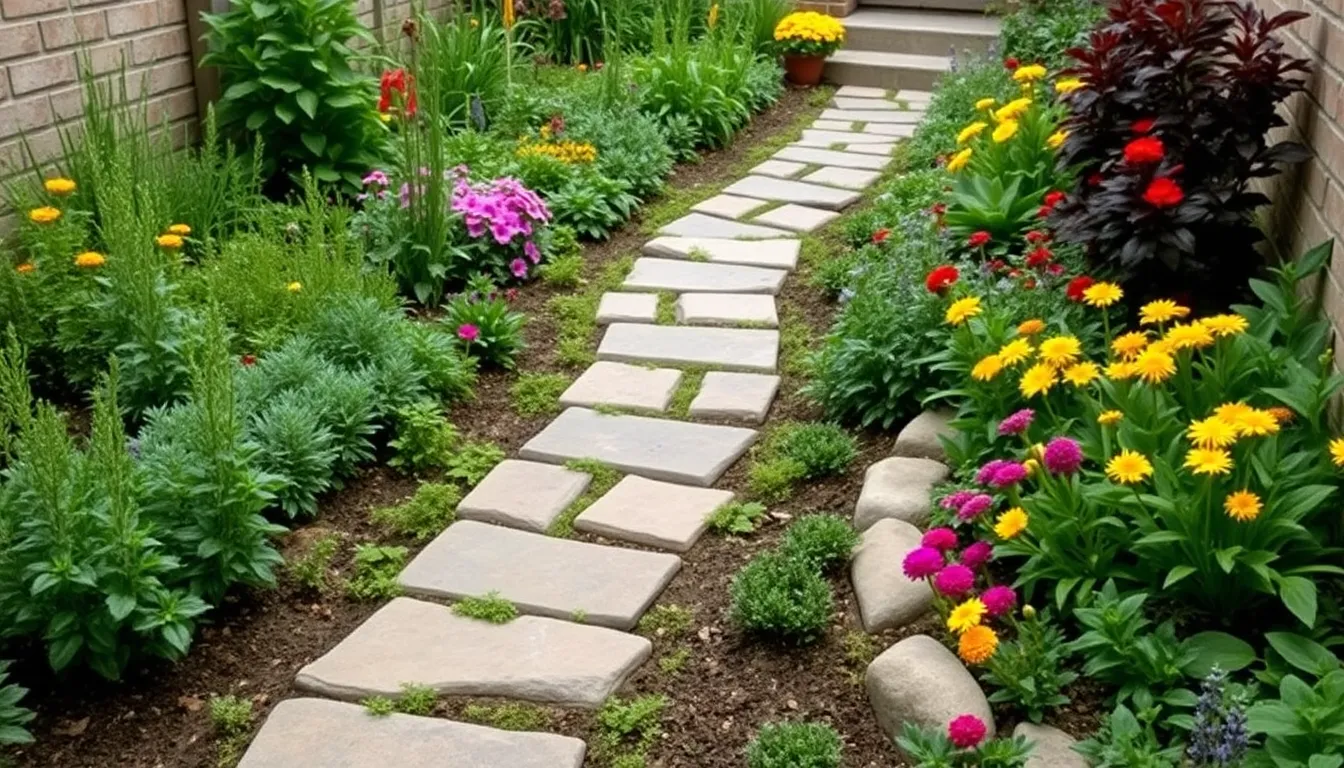
Smart pathway design transforms every square foot of our small yard into productive garden space. We’ll maximize our limited area by creating walkways that serve multiple purposes while maintaining easy access throughout our garden.
Create Herb-Lined Walkways for Dual Purpose
Herb lined walkways deliver fresh scents and cooking ingredients right at our fingertips. Planting fragrant herbs like thyme, rosemary, or oregano along pathway edges creates natural borders that release aromatic oils when we brush past them. These low maintenance herbs thrive in well draining conditions that pathway materials naturally provide.
Stone, brick, or gravel materials offer the best drainage and stability for our herb walkways. Gravel paths cost less and allow excellent water penetration, while stone provides durability and visual appeal. We can space herbs 12 to 18 inches apart along pathway edges to ensure adequate growing room and easy harvesting access.
Install Stepping Stone Gardens Between Plants
Stepping stones create pathways that protect our soil from compaction while adding visual interest. Placing stones strategically between plants allows us to reach every corner of our garden without damaging root systems or disturbing soil structure. This method works particularly well with succulents, small shrubs, and perennial flowers that benefit from undisturbed growing conditions.
We can use natural flagstone, concrete pavers, or decorative stepping stones spaced 18 to 24 inches apart for comfortable walking. Plants like hens and chicks, creeping thyme, or moss can grow between stones to create a living carpet effect. This approach maximizes our planting area while maintaining essential garden access.
Build Narrow Paths With Integrated Planting Strips
Narrow paths with built in planting strips optimize every inch of our small yard space. These functional walkways typically measure 2 to 3 feet wide with 6 to 12 inch planting strips running alongside them. We can construct them using brick, wood, or stone materials that complement our overall garden design.
Built in planting strips work perfectly for compact vegetables, annual flowers, or trailing plants that spill over pathway edges. Raised planting strips improve drainage and soil quality while creating defined growing zones. We can fill these strips with herbs, lettuce, or small flowering plants that add color and functionality to our garden pathways.
Optimize Natural Light With Strategic Plant Placement
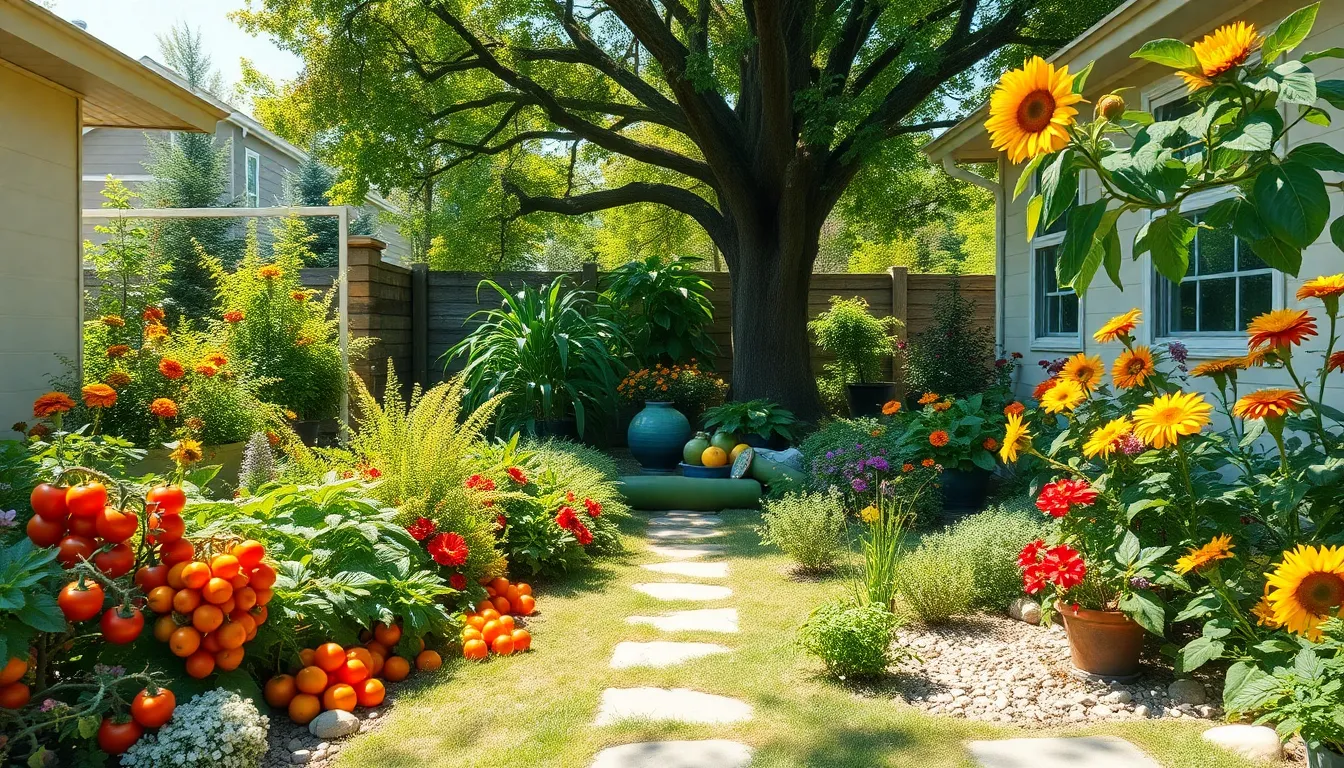
Understanding how light moves through our small yard throughout the day helps us make informed decisions about where to position each plant. We can dramatically improve plant health and garden productivity by matching plants to their ideal light conditions.
Position Sun-Loving Plants in Brightest Spots
Identifying full sun areas requires observing our yard during different times of day to locate spots receiving at least six hours of direct sunlight. We should track sun patterns from morning through afternoon to find these prime real estate locations for our most demanding plants.
Sun loving vegetables like tomatoes, peppers, and squash perform best when positioned in these brightest locations where they’ll receive maximum solar energy. These crops typically produce higher yields and develop better flavor when grown in full sun conditions.
Flowering plants such as roses, sunflowers, and marigolds thrive in bright spots and reward us with more abundant blooms. We can create stunning focal points by clustering these colorful performers in our sunniest corners and borders.
Monitoring plant performance helps us determine if we’ve chosen the right locations, as healthy sun plants display vigorous growth and rich foliage colors. Plants struggling in insufficient light often become leggy or produce fewer flowers and fruit.
Create Shade Gardens Under Trees and Structures
Utilizing existing shade structures like pergolas, arbors, and large trees provides opportunities to expand our growing space with shade tolerant plants. These areas often remain cooler during hot summer months, creating comfortable microclimates for both plants and people.
Shade loving plants including ferns, hostas, and astilbe flourish in these protected areas where direct sun would scorch their delicate foliage. We can create lush, textural gardens that feel like peaceful retreats using these naturally adapted species.
Layering different plant heights under trees mimics natural forest conditions and maximizes our use of vertical growing space. Tall shade perennials, medium height shrubs, and ground covering plants create depth and visual interest in these dimmer locations.
Improving soil conditions in shaded areas often requires adding organic matter since tree roots and structures can create dry, nutrient poor conditions. We can enhance these spots with compost and mulch to support healthy plant growth.
Use Reflective Surfaces to Maximize Available Light
Installing mirrors strategically bounces natural light into darker corners of our small yard, effectively extending the growing potential of marginal areas. We should position mirrors to reflect morning or afternoon sun into spots that receive limited direct sunlight.
Light colored stones and gravel create reflective ground surfaces that increase ambient light levels around nearby plants. These materials also provide attractive pathways and mulch alternatives while serving our light maximizing goals.
White or metallic planters reflect additional light upward toward plant foliage, creating brighter growing conditions than dark containers. We can use these reflective vessels strategically to boost light levels for plants positioned in partially shaded locations.
Reflective mulches like aluminum or light colored organic materials help direct more light to the lower portions of plants. This technique works particularly well for vegetables and flowering plants that benefit from additional light reaching their stems and lower leaves.
Conclusion
Small yards don’t have to limit our gardening dreams. With these innovative strategies we’ve explored we can transform even the tiniest outdoor spaces into thriving productive gardens that rival much larger landscapes.
The key lies in thinking vertically utilizing every available corner and choosing plants that maximize both beauty and function. Whether we’re building raised beds creating mobile container gardens or designing herb-lined pathways each technique helps us squeeze more growing potential from limited square footage.
Our small yard gardens can become incredibly rewarding spaces that provide fresh food beautiful flowers and peaceful retreats. With smart planning and creative design we’ll discover that size truly doesn’t matter when it comes to creating the garden of our dreams.
Frequently Asked Questions
What are the main benefits of vertical gardening in small spaces?
Vertical gardening can triple your planting capacity while enhancing visual appeal. It maximizes limited space by utilizing walls and vertical structures for growing herbs, flowers, and vegetables. Wall-mounted planters, fabric pocket systems, and trellises create additional growing areas without taking up valuable ground space, making small yards more productive and attractive.
How do mobile garden containers help with small yard gardening?
Mobile garden containers with wheels allow strategic plant positioning and seasonal movement. You can relocate plants to follow sunlight throughout the day, protect them from harsh weather, and extend growing seasons. This flexibility maximizes plant health and productivity while adapting to changing garden conditions and space requirements.
What are the best plants for narrow side yards and awkward corners?
Compact herbs like basil, thyme, and oregano work well in narrow spaces. For vegetables, choose cherry tomatoes, leafy greens, and dwarf varieties. Utilize tiered arrangements and custom-built planters for irregular areas. Select plants based on light conditions and space constraints to ensure maximum productivity in these challenging spots.
How can I create multi-level gardens in small yards?
Build raised garden beds for better organization and drainage. Use terraced systems on slopes to prevent erosion and create separate planting zones. Implement stepped planting arrangements on patios using containers of varying heights. These techniques maximize growing space while improving accessibility and visual interest in compact areas.
What are space-saving edible garden solutions for small yards?
Focus on high-yield, compact plants like dwarf fruit trees in containers, cherry tomatoes, and cut-and-come-again vegetables. Design kitchen gardens with succession planting for continuous harvests. Choose varieties specifically bred for small spaces and containers to maximize food production while minimizing space requirements.
How can pathways double as growing areas in small gardens?
Create herb-lined walkways using aromatic plants alongside stone or gravel paths. Install stepping stones to protect soil while providing plant access. Design narrow paths with integrated planting strips for compact vegetables and flowers. This approach maximizes every square foot while maintaining garden functionality and accessibility.
What’s the best way to optimize light in small, shaded gardens?
Position sun-loving plants in the brightest yard areas first. Create shade gardens under trees using shade-tolerant plants like hostas and ferns. Use reflective surfaces such as mirrors and light-colored materials to redirect sunlight into darker corners, effectively expanding your growing options and improving plant performance.

